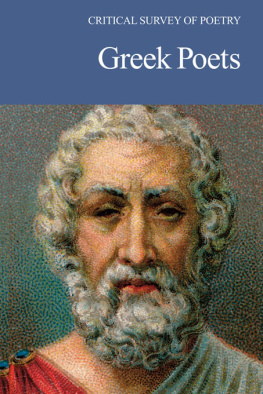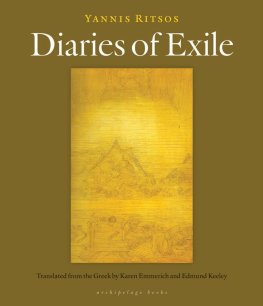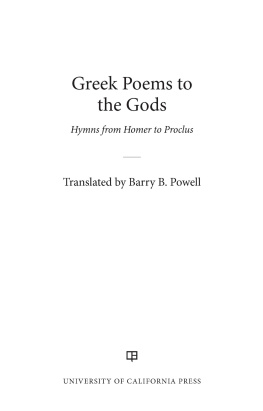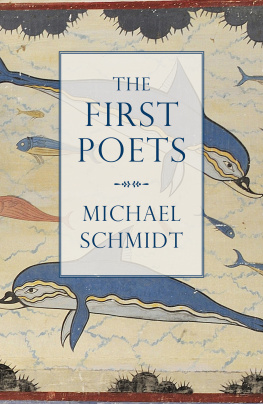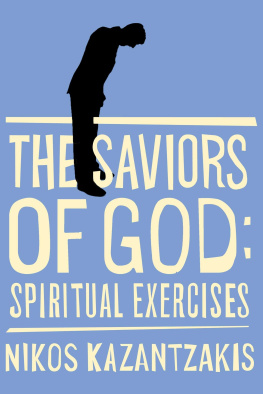

Cover photo:
Homer ( PoodlesRock/Corbis)
Copyright 2012, by Salem Press, A Division of EBSCO Publishing, Inc.
All rights in this book are reserved. No part of this work may be used or reproduced in any manner whatsoever or transmitted in any form or by any means, electronic or mechanical, including photocopy, recording, or any information storage and retrieval system, without written permission from the copyright owner except in the case of brief quotations embodied in critical articles and reviews or in the copying of images deemed to be freely licensed or in the public domain. For information address the publisher, Salem Press, at csr@salempress.com.
eISBN: 978-1-58765-911-9
CONTENTS
Peter Bien
University of Massachusetts,Dartmouth
J. R. Broadus
University of North Carolina
Peter Constantine
New York, New York
Carrie Cowherd
Howard University
J. Madison Davis
Pennsylvania State College-Behrend College
Andonis Decavalles
Fairleigh DickinsonUniversity
Desiree Dreeuws
Sunland, California
Jack Ewing
Boise, Idaho
Daniel H. Garrison
Northwestern University
Sarah Hilbert
Pasadena, California
Tracy Irons-Georges
Glendale, California
Maura Ives
Texas A&M University
Rebecca Kuzins
Pasadena, California
John M. Lee
James Madison University
Richard Peter Martin
Princeton University
Laurence W. Mazzeno
Alvernia College
Vasa D. Mihailovich
University of North Carolina
Christina J. Moose
Pasadena, California
Adriano Moz
Spring Hill College
Evelyn S. Newlyn
Virginia PolytechnicInstitute and StateUniversity
Rosemary M. Canfield Reisman
Charleston SouthernUniversity
Minas Savvas
San Diego State University
Thomas J. Sienkewicz
Monmouth College
James Stone
Shaker Heights, Ohio
George Thaniel
University of Toronto
Karen Van Dyck
Columbia University
Michael Witkoski
University of South Carolina
The earliest Greek poetry was unlettered, oral, and traditional. For centuries before the appearance of the alphabet in the eighth century B.C.E., Greek poets were creating songs, probably in dactylic hexameter, for entertainment, ritual, and religious purposes. Some of these poems were probably short lyrics and others were longer tales about their heroes and gods. Most, if not all, were probably intended for public performance by individuals or by choruses. Especially in longer, narrative poetry, fixed phrases such as epithets and formulas were used as mnemonic devices and compositional tools to tell and retell tales through generations.
HOMER
While the texts of the earliest surviving Greek poetry, the Homeric epics Iliad (c. 750 B.C.E.; English translation, 1611) and Odyssey (c. 725 B.C.E.; English translation, 1614), were probably not written down in definitive form until the eighth century B.C.E., the tales on which they are based may have existed in oral form at least by the late second millennium B.C.E. Although the very existence of their author is clouded in controversy, few challenge their authors debt to a long chain of earlier poets who helped establish tales about a ten-year-long war between the Greeks and the Trojans and the troublesome homecomings of the Greeks after their victory. Homers Iliad deals only with the tenth year of the war and the consequences of the quarrel between the Greek leader Agamemnon and his chief warrior Achilles. The Odyssey focuses on the ten-year wanderings of the Greek warrior Odysseus following the war and the troubles he faced when he finally arrived home in Ithaca. Many other tales surrounding these events were part of a tradition called Trojan cycle. Some were concerned with the events leading up to the war or with the nine years of conflict prior to the Iliad, others with events following the Iliad and with the end of the war. There were also other homecoming tales besides that of Odysseus, and even stories about other wars, such as that known as the Seven Against Thebes, but none of these survives except in fragments.
Also surviving under Homers name, but probably written by a number of anonymous authors, are the Homeric hymns, a collection of thirty-three songs to individual Greek deities. Thought to have been sung as preludes or introductions, especially for performances of Greek epics, these hymns use the dactylic hexameter and vocabulary of Homer and usually include the traditional parts of a prayer, with an invocation, sanction, and entreaty to the god. A few of these hymns, specifically those to Demeter (2), Apollo (3), Hermes (4), Aphrodite (6), and Dionysus (7), incorporate significant narrative sections telling stories about these deities.
HESIOD
In his two surviving poems Theogonia (c. 700 B.C.E.; Theogony, 1728) and Erga kaiEmerai (c. 700 B.C.E.; Works and Days, 1618), the poet Hesiod (fl. c. 700 B.C.E.) also uses the hexameter and language of Homer but in an often personal, didactic tone. In Theogony, Hesiod focuses on the birth of the gods and the violent succession of divine rulers from Uranus to Cronus to Zeus. Works and Days, usually described as a farming manual, is rather a statement of Hesiods own philosophy and worldview. In his personal poetic voice, he celebrates the justice of Zeus, describes the evils of women, and reflects on his own divine calling to be a poet. Other well-known myths told by Hesiod in these poems include the stories of the Titan Prometheus and of the first woman, Pandora.
FIRST-PERSON POETRY
Hesiods poetry marks a transition in the seventh century B.C.E. from the traditional, oral poetry represented by the surviving Homeric epics to shorter, more individualized verse that often uses this traditional language in novel ways. In most cases, this poetry, like the Homeric epics, continues to be composed for performance rather than for publication. Most of this poetry survives only in short fragments culled from references in later works or found on scraps of Egyptian papyri. These poems are written in a variety of meters, styles, and dialects. Some, like elegy, use the traditional dactylic hexameter, but accompanied by a second line, in dactylic pentameter, to form an elegiac couplet. It is possible that the origin of the word elegy is derived from a non-Greek word for flute. This poetry was, in fact, often sung to the accompaniment of such musical instruments. Occasionally the Greeks themselves mistakenly assumed that the word meant lament, but such poetry is especially associated with commemoration of the dead only in the Greek tombstone inscription tradition. Ancient Greek poems written in a variety of other meters are usually called lyric, after a stringed-instrument the Greeks called the lyre. A third important type of personal verse used an iambic meter especially for invective or poetry of personal attack. While metrical form and theme are closely associated in Greek poetry, such metrical features are rarely discernible in English translation. All of these varied verse forms, however, share an emphasis on personal self expression, reflection, and, especially, the use of the first person.
Next page
